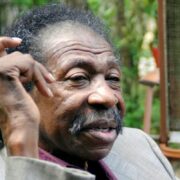— Associated Press, TIME
(SELMA, Ala.) — Bruce Carver Boynton, a civil rights pioneer from Alabama who inspired the landmark “Freedom Rides” of 1961, died Monday. He was 83.
Former Alabama state Sen. Hank Sanders, a friend of Boynton’s, on Tuesday confirmed his passing.
Boynton was arrested 60 years ago for entering the white part of a racially segregated bus station in Virginia and launching a chain reaction that ultimately helped to bring about the abolition of Jim Crow laws in the South. Boynton contested his conviction, and his appeal resulted in a U.S. Supreme Court decision that prohibited bus station segregation and helped inspire the “Freedom Rides.”
Featured Image, In this Thursday, May 3, 2018 photo, Bruce Carver Boynton speaks at his home in Selma, Ala. Boynton, a civil rights pioneer from Alabama who inspired the landmark “Freedom Rides” of 1961, has died. He was 83. Former Alabama state Sen. Hank Sanders, a friend of Boynton’s, confirmed his passing Friday, Nov. 20, 2020. Jay Reeves–AP
Full Article @ TIME
— Related
Freedom Riders were civil rights activists who rode interstate buses into the segregated Southern United States in 1961 and subsequent years to challenge the non-enforcement of the United States Supreme Court decisions Morgan v. Virginia (1946) and Boynton v. Virginia (1960), which ruled that segregated public buses were unconstitutional. The Southern states had ignored the rulings and the federal government did nothing to enforce them. The first Freedom Ride left Washington, D.C. on May 4, 1961, and was scheduled to arrive in New Orleans on May 17.
Boynton outlawed racial segregation in the restaurants and waiting rooms in terminals serving buses that crossed state lines. Five years prior to the Boynton ruling, the Interstate Commerce Commission (ICC) had issued a ruling in Sarah Keys v. Carolina Coach Company (1955) that had explicitly denounced the Plessy v. Ferguson (1896) doctrine of separate but equal in interstate bus travel. The ICC failed to enforce its ruling, and Jim Crow travel laws remained in force throughout the South.[citation needed]
The Freedom Riders challenged this status quo by riding interstate buses in the South in mixed racial groups to challenge local laws or customs that enforced segregation in seating. The Freedom Rides, and the violent reactions they provoked, bolstered the credibility of the American Civil Rights Movement. They called national attention to the disregard for the federal law and the local violence used to enforce segregation in the southern United States. Police arrested riders for trespassing, unlawful assembly, violating state and local Jim Crow laws, and other alleged offenses, but often they first let white mobs attack them without intervention.
The Congress of Racial Equality (CORE) sponsored most of the subsequent Freedom Rides, but some were also organized by the Student Nonviolent Coordinating Committee (SNCC). The Freedom Rides, beginning in 1960, followed dramatic sit-ins against segregated lunch counters conducted by students and youth throughout the South, and boycotts of retail establishments that maintained segregated facilities.
The Supreme Court’s decision in Boynton supported the right of interstate travelers to disregard local segregation ordinances. Southern local and state police considered the actions of the Freedom Riders to be criminal and arrested them in some locations. In some localities, such as Birmingham, Alabama, the police cooperated with Ku Klux Klan chapters and other white people opposing the actions, and allowed mobs to attack the riders.
Source – Freedom Riders (Updated: 22 November 2020) Wikipedia. Available at https://en.wikipedia.org/wiki/Freedom_Riders, (Accessed: 25 November 2020)

